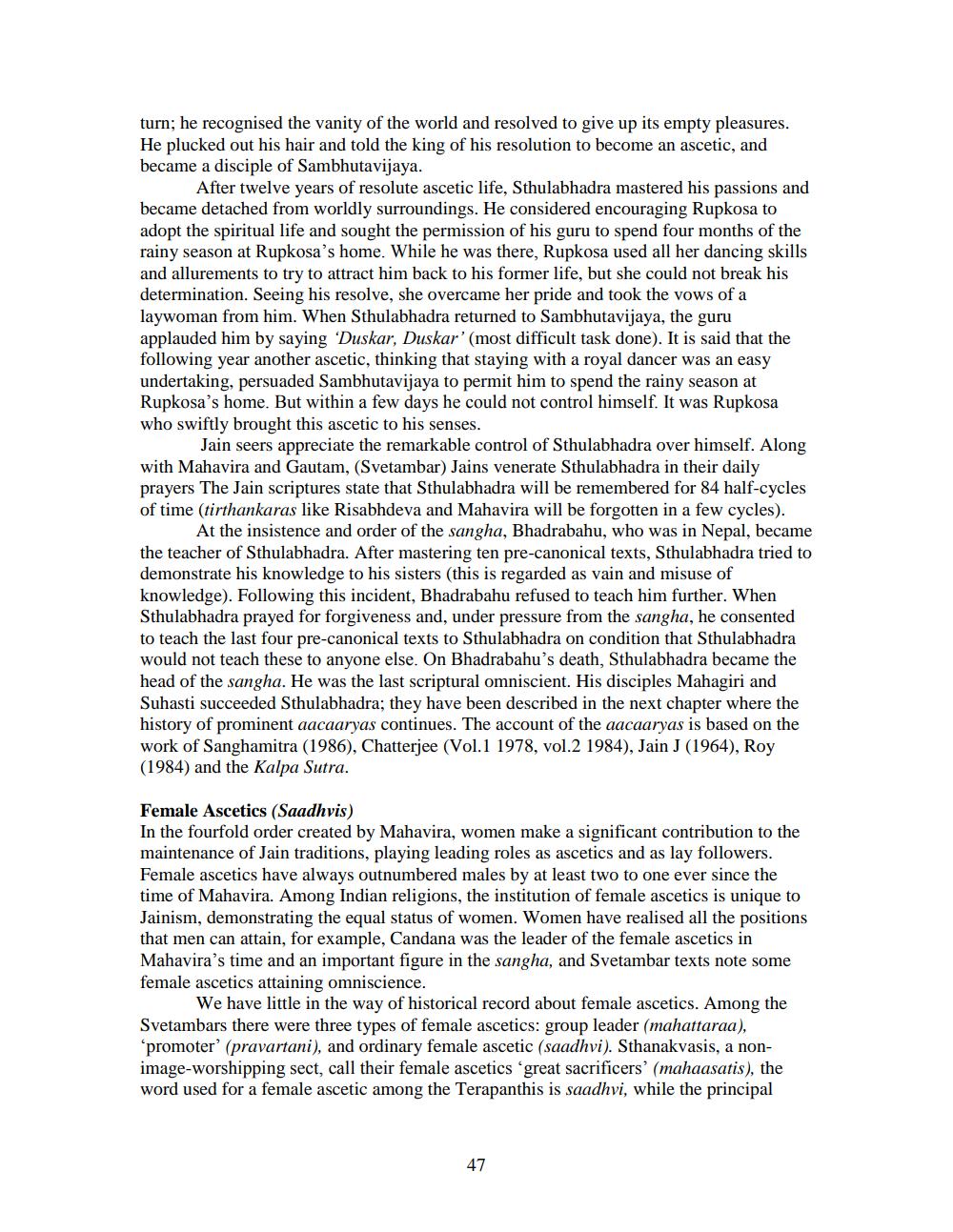________________
turn; he recognised the vanity of the world and resolved to give up its empty pleasures. He plucked out his hair and told the king of his resolution to become an ascetic, and became a disciple of Sambhutavijaya.
After twelve years of resolute ascetic life, Sthulabhadra mastered his passions and became detached from worldly surroundings. He considered encouraging Rupkosa to adopt the spiritual life and sought the permission of his guru to spend four months of the rainy season at Rupkosa's home. While he was there, Rupkosa used all her dancing skills and allurements to try to attract him back to his former life, but she could not break his determination. Seeing his resolve, she overcame her pride and took the vows of a laywoman from him. When Sthulabhadra returned to Sambhutavijaya, the guru applauded him by saying 'Duskar, Duskar' (most difficult task done). It is said that the following year another ascetic, thinking that staying with a royal dancer was an easy undertaking, persuaded Sambhutavijaya to permit him to spend the rainy season at Rupkosa's home. But within a few days he could not control himself. It was Rupkosa who swiftly brought this ascetic to his senses.
Jain seers appreciate the remarkable control of Sthulabhadra over himself. Along with Mahavira and Gautam, (Svetambar Jains venerate Sthulabhadra in their daily prayers The Jain scriptures state that Sthulabhadra will be remembered for 84 half-cycles of time (tirthankaras like Risabhdeva and Mahavira will be forgotten in a few cycles).
At the insistence and order of the sangha, Bhadrabahu, who was in Nepal, became the teacher of Sthulabhadra. After mastering ten pre-canonical texts, Sthulabhadra tried to demonstrate his knowledge to his sisters (this is regarded as vain and misuse of knowledge). Following this incident, Bhadrabahu refused to teach him further. When Sthulabhadra prayed for forgiveness and, under pressure from the sangha, he consented to teach the last four pre-canonical texts to Sthulabhadra on condition that Sthulabhadra would not teach these to anyone else. On Bhadrabahu's death, Sthulabhadra became the head of the sangha. He was the last scriptural omniscient. His disciples Mahagiri and Suhasti succeeded Sthulabhadra; they have been described in the next chapter where the history of prominent aacaaryas continues. The account of the aacaaryas is based on the work of Sanghamitra (1986), Chatterjee (Vol.1 1978, vol.2 1984), Jain J (1964), Roy (1984) and the Kalpa Sutra.
Female Ascetics (Saadhvis) In the fourfold order created by Mahavira, women make a significant contribution to the maintenance of Jain traditions, playing leading roles as ascetics and as lay followers. Female ascetics have always outnumbered males by at least two to one ever since the time of Mahavira. Among Indian religions, the institution of female ascetics is unique to Jainism, demonstrating the equal status of women. Women have realised all the positions that men can attain, for example, Candana was the leader of the female ascetics in Mahavira's time and an important figure in the sangha, and Svetambar texts note some female ascetics attaining omniscience.
We have little in the way of historical record about female ascetics. Among the Svetambars there were three types of female ascetics: group leader (mahattaraa),
promoter' (pravartani), and ordinary female ascetic (saadhvi). Sthanakvasis, a nonimage-worshipping sect, call their female ascetics 'great sacrificers' (mahaasatis), the word used for a female ascetic among the Terapanthis is saadhvi, while the principal




